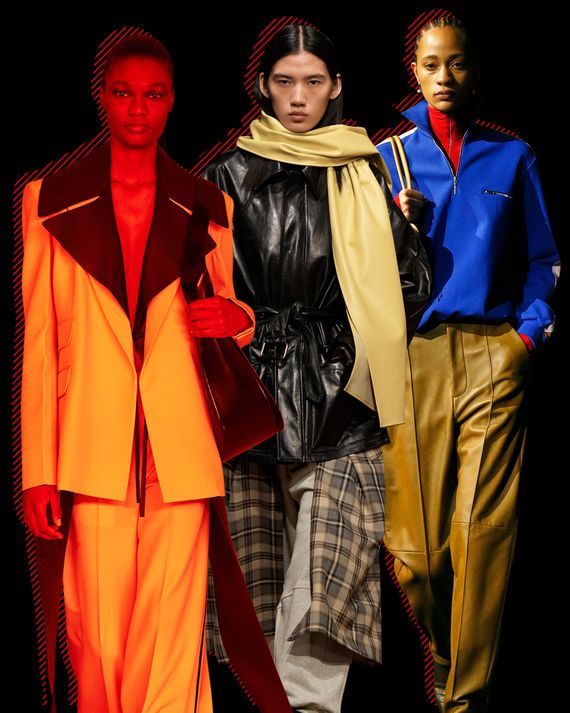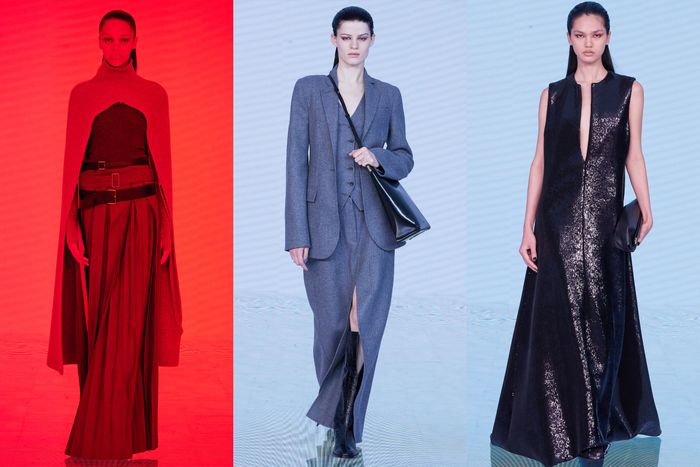
Peter Do called his new collection — shown in Genesis House in Chelsea — “Foundation.” That sounds grandiose, considering it was only Do’s second runway show. But the designs did more than live up to the name. They added a rich layer to the ground of New York fashion.
It’s been a long time coming. Although New York can grow plenty of streetwear and the type of offbeat designs that might be lumped under the header “anti-fashion,” it has not produced many new labels in the coat-and-suit tradition of Seventh Avenue. And for good reasons. For one, our lives are not as formal as they once were, demanding similar garments. And for another, the infrastructure that once supported that kind of fashion — great stores with knowledgeable sales staff, local factories — is under serious stress. European brands, by contrast, are able to go deep in tailoring because they often own their factories, and they have a network of mom-and-pop retailers who can sell it.
But Do also knows how to make a statement. That’s the big-picture difference with him. He knows it’s not enough to do nice tailoring — and, for the sake of fashion, add a novel flourish or pump up the shoulders. No, he has to make his tailoring look youthful. At the same time, he has to create a total and consistent vision around it so that every piece feels in harmony with the whole.
It’s a tall order. Nonetheless, Do met it. He did a number of variations on the suit with the cut of the jacket essentially staying the same. (He did offer an oversize version with basting thread as a plain graphic detail, as well as a boxy cut.) Several coats featured a wide contrasting panel set on the bias with the pattern repeated on the pants or skirt. In a few outfits, there were long, floaty panels. Their main function seemed to be to give a sense of movement or to break up the severity.
The newest suiting look was also the oldest — a gray wool jacket with a matching waistcoat and long slim skirt. However, Do made it look new by treating the vest and the skirt as one piece, putting a deep slit in the front of the skirt, and showing the outfit with black boots. It looked sensational. Clearly Do built his collection around a concise number of geometric forms — forms recognizably to anyone living in a city with skyscrapers and grids — and he stuck to a narrow palette, using only a shiny black surface (for a perfect, slightly flared long shift) or black leather for evening. But the fact that he applied those same design limits to his casual styles was impressive. He showed sweaters that were a cross between a shrug and a stole and that swept over the arms to the knees. They were interesting in their own right, as was a black leather halter top–slash–vest that looked elegant and modern for evening.
It’s rare when you get up from a fashion show and can’t wait to see what a designer will cook up the next season. So, kudos to Do and his team.
When you think how old the modern masculine suit is — its origins go back to the late 18th century — it’s always astonishing when a designer can find another way to update it. And it’s telling how durable the form is. As she has done before, Gabriela Hearst made tailoring a pillar of her collection along with signature knitwear. But she didn’t really advance the form, apart from doing the storm flaps of dark leather trench coats in a woven blend of leather and crêpe de chine or adding lace panels to a white leather trench — a detail that makes me think of Dior.
Hearst’s earth-tone knits were generally striking, in particular a silk and cashmere poncho with a multihued swirled pattern based on a drawing called A Winter Horse, by the artist Ana Martinez Orizondo, who goes by Amo. And a slim black merino knit dress with a square neckline and puffy, to-the-elbow sleeves in ivory silk was enchanting.
For some reason, though, Hearst feels the need to accompany her collection with messages that can read as virtue signaling — whether it’s the amount dead stock or recycled fabric she used, the carbon emissions from the show site (the Brooklyn Navy Yard), or a comment in her multipage show notes from a Stanford professor on gender. Surely, on the subject of gender, Hearst is preaching to the choir. There’s also the environmental impact, not to mention the wasted time, of most guests traveling to the industrial venue by big luxury cars.
In her collection, Tory Burch covered the waterfront — classic sportswear with an athletic feel, wool bouclé jackets belted over cute, multilayered skirts in cotton poplin, and some long fit-and-flare jersey dresses and separates with geometric color blocking. The jersey items were her best looks. Burch, in her notes, called the collection “a toolbox for expressing individual style,” after observing that New York is a city of characters. True, but Burch didn’t express that individuality in her casting, which was racially mixed but uniformly the same body shape — with clone-like, neat hairstyles.
The dark-haired, middle-aged woman who wore the black pantsuit in Maryam Zadeh’s show was Lizzi Bougatsos, a founder of the punk band Gang Gang Dance. I sensed she was someone special, but who knew?
Zadeh’s designs are not really fashion, and they’re not anti-fashion, either. They are clothes, but Zadeh has such a feeling for the women and men, true characters, she dresses in her mind that something magical usually happens at her shows. I found myself intrigued by the woman in a tough, belted black leather jacket layered over a muddy-brown plaid shirt with her white pants stuffed into boots — and wondering about a girl in a navy crewneck with a plain-Jane A-line skirt and mismatched pumps. She would be the coolest girl in the office, I thought, but the reasons aren’t obvious.
Zadeh, who had German New Wave colors on her inspiration board, said she was after “a soulful elegance.” That showed. And she added that her goal when styling her models, some of whom are friends, is to create “amplified versions of themselves.” That’s what a designer’s eye can do.
Finally, I was impressed with a new line, Câllas Milano, in its second season. Created by Jan-Hendrik Schlottmann (who is the real-life partner of Derek Lam) and Marco Panzeri, an Italian manufacturer, Callas fills a void for wardrobe styles with a practical, worldly sensibility. It includes a sharp pantsuit in hot pink or camel-colored washed velvet, silk-print separates, the perfect trench, and a white bouclé suit with a slit-front skirt that’s a nice nod to Chanel. Everything is beautifully made. Of course — it’s made near Crema, in the Panzeri family factory.
More From New York Fashion Week
- No Sesso’s Designers on the Art of Showing Skin
- The Tyranny of the Bandage Dress Has Returned
- What You Missed at New York Fashion Week











